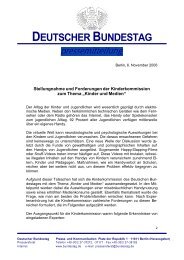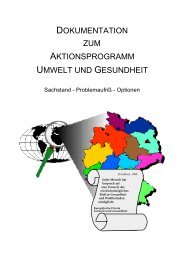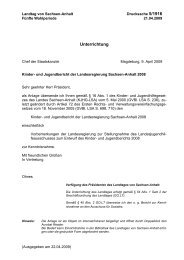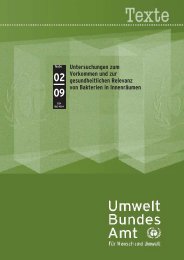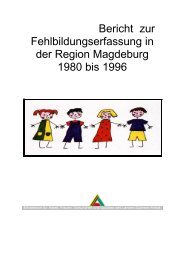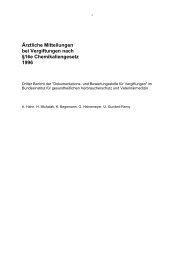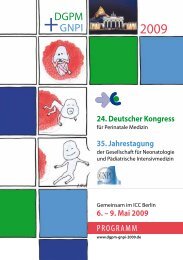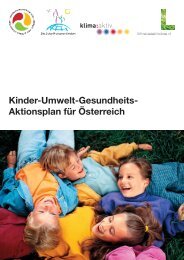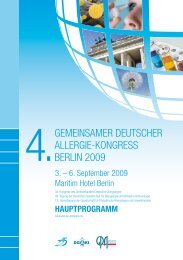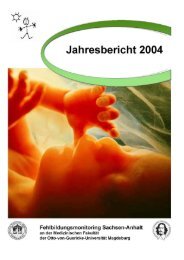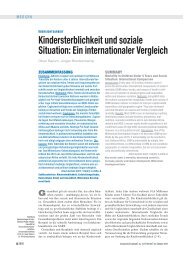Wiener Gesundheits- und Sozialsurvey Vienna Health and Social ...
Wiener Gesundheits- und Sozialsurvey Vienna Health and Social ...
Wiener Gesundheits- und Sozialsurvey Vienna Health and Social ...
Sie wollen auch ein ePaper? Erhöhen Sie die Reichweite Ihrer Titel.
YUMPU macht aus Druck-PDFs automatisch weboptimierte ePaper, die Google liebt.
threshold, however, life expectancy strongly depends on<br />
a country’s economic performance.<br />
The self-objectified areas of health considered for our<br />
purpose included ailments or symptoms felt in the past<br />
two weeks as well as chronic diseases. 78.5 percent of<br />
women <strong>and</strong> 71.2 percent of men of all ages claim to have<br />
been afflicted by at least one of the ailments listed. Most<br />
frequent ailments for men <strong>and</strong> women are pains in the<br />
locomotor system which increase drastically with age.<br />
Approximately 20 percent of men <strong>and</strong> 25 percent of<br />
women suffer from fatigue independent of age. 26.1 percent<br />
of women <strong>and</strong> approximately 16 percent of men often<br />
suffer from headaches. Other frequent ailments include<br />
sleeping disorders (19.1 percent of women <strong>and</strong><br />
13.2 percent of men are afflicted) which become more<br />
frequent with age. Hearing <strong>and</strong> vision impairment,<br />
weakness of memory <strong>and</strong> incontinence are common ailments<br />
in old age. Lower income groups are afflicted by<br />
the majority of ailments two or three times as often as<br />
others. This is true particularly for psychosomatic disorders,<br />
such as depressions, depressive moods, headaches,<br />
anxiety/nervousness, fatigue <strong>and</strong> exhaustion. The above<br />
distinction is less apparent with joint aches, stomach<br />
<strong>and</strong> digestive disorders, shortness of breath, inability to<br />
concentrate <strong>and</strong> sleeping disorders (with women).<br />
By far the most common allergy is rhinitis which only<br />
occurs at certain times of the year. Mainly younger men<br />
(17.9 percent) <strong>and</strong> women (14.2 percent) between 25<br />
<strong>and</strong> 44 years of age are afflicted. It occurs less with increasing<br />
age <strong>and</strong> is rarely fo<strong>und</strong> among people in lower<br />
positions. The number of allergies <strong>and</strong> allergens drops<br />
with increasing age. Unlike most ailments, allergies <strong>and</strong><br />
reactions to allergens are more frequent among people<br />
with higher education.<br />
As a whole, the number of ailments suffered by men <strong>and</strong><br />
women drops as the level of income <strong>and</strong> education rises.<br />
There is no similar correlation between the frequency of<br />
ailments <strong>and</strong> the level of professional status.<br />
Unlike as with ailments, the number of men <strong>and</strong> women<br />
suffering from at least one chronic disease is approximately<br />
the same with 30 percent each. The prevalence of<br />
chronic diseases increases with age, from between 7 percent<br />
<strong>and</strong> 10 percent among 16 to 24 year olds to approximately<br />
60 percent among people aged 74 <strong>and</strong> above.<br />
However, this also means that aro<strong>und</strong> 40 percent of people<br />
in the age group above 75 do not suffer from chronic<br />
WIENER GESUNDHEITS- UND SOZIALSURVEY<br />
SUMMARY AND CONCLUSIONS<br />
diseases at all <strong>and</strong> a further 10 percent are hardly restricted<br />
or not restricted at all by their illness. The majority<br />
of people suffering from chronic diseases, more than<br />
90 percent, claim to be fairly or extremely restricted in<br />
their daily lives. People in higher income brackets in the<br />
age group above 45 develop far fewer chronic diseases.<br />
This is true particularly for women, the difference in<br />
prevalence between the lowest <strong>and</strong> the highest income<br />
level being almost 50 percent. There is a similar difference<br />
between the lowest <strong>and</strong> highest educational level, a<br />
correlation which did not appear so for the different professional<br />
levels.<br />
Both men <strong>and</strong> women primarily suffer from diseases of<br />
the locomotor system, followed by circulatory diseases<br />
<strong>and</strong> diseases of the respiratory organs. The number of<br />
circulatory diseases rapidly increases with retired people,<br />
particularly men. One in five men <strong>and</strong> one in seven<br />
women are afflicted. Drastic increases with age were also<br />
noted in the number of endocrinologic diseases (nutritional<br />
<strong>and</strong> metabolic disorders), diseases of the nervous<br />
system <strong>and</strong> the sensory organs, as well as in the number<br />
of injuries. Circulatory diseases <strong>and</strong> diseases of the locomotor<br />
system in particular are conspicuously less frequent<br />
among people at higher income levels. Similarly,<br />
there is a strong correlation between the level of education<br />
<strong>and</strong> the number of endocrinologic <strong>and</strong> psychiatric<br />
disorders, diseases of the nervous system <strong>and</strong> injuries, all<br />
of which are less frequent among people at higher educational<br />
levels. In the age group above 45, people in the<br />
lowest income bracket suffer from diabetes five times as<br />
often as those in the highest income bracket. Hypertonia<br />
is also widespread among people in the age group above<br />
45, with approximately 22 percent of men <strong>and</strong> 8 percent<br />
of women being affected. The frequency of hypertonia<br />
decreases with increasing income, most visibly so in the<br />
case of women, where numbers go down to one fifth.<br />
Approximately 8.5 percent of men <strong>and</strong> the same number<br />
of women suffered at least one leisure time accident in<br />
the course of one year. Leisure accidents are most widespread<br />
in the youngest age group, i.e. among people aged<br />
16 to 24. Most of these are sports accidents, 50 percent in<br />
the case of men, 30 percent in the case of women. People<br />
in the highest income bracket are injured least often,<br />
those in the lowest income bracket most often so.<br />
We then looked at the number of people in <strong>Vienna</strong> suffering<br />
from disabilities or restrictions in their daily lives<br />
resulting from diseases or injuries. Aro<strong>und</strong> 18 percent of<br />
39



